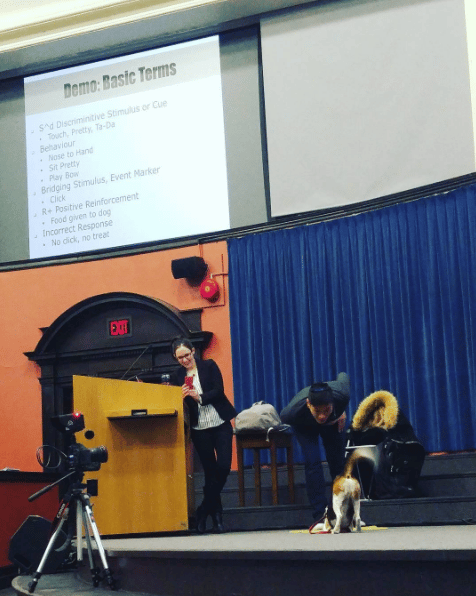Dear Dog Training Professional:
If I know you’re good, you’ve gotten referrals from me.
I don’t travel far to see clients, and neither do the other trainers here. My general rule of thumb is, if I can’t bike there in 20 minutes from one of our locations, then it’s too far. I have my reasons – carbon footprint (I bike to most of my appointments), spending time helping people and their dogs (not stuck in traffic), amongst others.
As a result, over the last six years, I’ve maintained relationships with dog training professionals across the Toronto area, and this is why we refer people to dog trainers, behaviour consultants, and if appropriate, veterinary behaviourists in North York, Richmond Hill, Mississauga, and beyond.
I attend the same continuing education seminars they attend. They take many of the same online courses I have. They’ve read the same books. They have completed programs with the Pat Miller Academy, Karen Pryor Academy, or Jean Donaldson’s Academy For Dog Trainers.
By what they blog about, post on Facebook, and the education they have, I know they are good. That’s why I refer people to them.
Referrals Gone Wrong
Recently, I referred group class clients of ours to a dog trainer colleague who operates north of the 401 (beyond where we travel for in-home lessons). She provided private lessons in-home for a variety of things, including basic clicker training, and some help getting their dog to be less anxious in busy traffic using basic desensitization and counter-conditioning protocols. Our clients spoke highly of HER services.
I was, however, surprised to hear that when our mutual client’s dog had nipped a stranger entering the house, the colleague who I referred to them said it was beyond her level of expertise and comfort, and instead, referred to ANOTHER trainer with experience with “aggression” issues.
The OTHER trainer told the client that the reason why their dog nipped a stranger in the house is because he is coddled excessively.
… wait just a minute?
The Four Stages of Competence
Why did she (who I will call Dog Trainer Colleague Who Undersells Themselves), who actually HAS this knowledge, second-guess herself and question her own abilities?
Why did she pass off our client to such a Dog Trainer Charlatan? It takes only a small amount of knowledge around learning theory (specifically, associative learning in this case) to know that coddling does not contribute to a dog nipping a stranger in the house.
Why do these Dog Trainer Charlatans have such confidence to take on cases involving fear and aggression, when they are so ignorant of even undergraduate level psychology?
It’s because the more you know, the less you feel you know.
And the less you know, the more likely you are to feel like you know everything.
The Four Stages of Competence is a learning model developed in the 1970s that I frequently think about when learning any new skill. These are definitions both textbook but also with some of my own opinion added in. The stages are:
- Unconscious Incompetence – The individual does not understand or know of something, or recognize there is any knowledge deficit. They are blissfully unaware of their own incompetence and as a result are grossly overconfident.
- Conscious Incompetence – The individual does not understand something, but is conscious of the fact there is a knowledge and skill deficit. They are aware of their own incompetence and as a result, can self-assess what he or she is capable of doing, or not capable of doing.
- Conscious Competence – The individual has acquired the knowledge and skill to perform the tasks in question, but it’s new, so it requires a lot of concentration. It needs to be broken down into small steps as executed, and as a result, not a lot of deviation, experimentation occurs when performing the task.
- Unconscious Competence – Mastery achieved through thousands of hours of practice. Tasks can be done effortlessly and because of this, it’s possible for the individual to deviate, experiment, and innovate as they perform their craft.
Dog Trainer Charlatan – Has been stuck in Stage 1 for so long, they are blissfully unaware of the fact they are ignorant beyond belief, and BELIEVE they are qualified to help people with dogs with serious issues, and tell people so. They’re totally unaware they are unqualified and basically just making shit up and winging it.
Dog Trainer Colleague Who Undersells Themselves – Is really in Stage 3 or possibly Stage 4, but for whatever reason, is stuck on the self-doubt associated with Stage 2. They know their stuff, but is hesitant because of their mindset or perhaps lack of a support system.
This phenomenon (Underqualified people being overly confident in their ability / Qualified people being under-confident) is actually a *thing* – the Dunning-Kruger Effect.
The Dunning–Kruger effect is a cognitive bias in which unskilled persons mistakenly assess their ability to be much higher than it really is. The collary effect – highly skilled persons underestimate their relative competence.
What Does This Mean For Consumers?
If a dog owner has a serious issue on their hands (example: Dog has bitten neighbour, Level 3 bite, puncture) and they contact 5 dog trainers – I’d bet that 3 of these trainers will have sufficient qualifications and skills, and 2 of these trainers will be unskilled charlatans.
The odds of this dog owner ending up one of the unqualified 2 is very high.
The first 3 trainers are the most qualified, but because of their knowledge, they are thoughtful in their self-assessment and may be reluctant to take cases like this because they’ve yet to earn enough CEUs (Continuing Education Units) from seminars on people-directed aggression, or haven’t done their Level 3 workshop yet with Pat Miller, or would want to have an Certified Applied Animal Behaviorist (CAAB) supervising their consultation, but don’t have one in their network.
The last 2 charlatans are blissfully ignorant – they’ve watched all four seasons of The Dog Whisperer, had some feral dogs growing up and “tamed” them, and don’t know what they don’t even know.
The sad truth of the matter is, based on the cognitive biases of all 5 trainers, it’s likely this dog is going to end up with the least qualified person available to help it. Those that are good enough believe they aren’t good enough, and those that are unqualified think they are qualified.
Charlatans Take Any Dog, All Cases, No Challenge Too Great!
If you are that dog training professional that has invested the time and actually understands concepts like desensitization, associative learning, and abides by frameworks such as Dr. Susan Friedman’s Humane Hierarchy, I’m writing this for YOU.
I respect you may have limits to the types of cases you take on, but you need to understand what happens when you say no.
The consumer (and their dogs) end up with unqualified hacks that employ harsh aversives, flooding, and just downright crappy behaviour modification. In the most frightening cases, they believe they are qualified to help dogs with cognitive and neurological disorders. Here are some examples of their expertise in action:
Over-threshold exposures, many leash corrections (mild but ineffective aversives), flooding (dog forced to stay in area until it is physically exhausted)
Fearful dogs forced outside, any option to flee removed. Flooding and learned helplessness. Sensitization is likely to occur, including new stimulus (children walking on the street may now exhibit a fear response)
Aggressive dogs subjected to triggers at full intensity, then hit with very severe aversives. Aggressive displays suppressed, now strangers get to pet the dog (and get bit in the face since all warning signs have been punished). This trainer may know how to title a dog in Schutzhund, but he has a lot to learn about behaviour modification.
If Not You, Then Who?
If we do not step up and help dogs with fear, anxiety, and aggression issues, dogs with these issues end up with these people. The misguided belief that you need to use aversives to stop aggressive behavior will build momentum, since the only people that end up taking these cases only know how to use flooding and aversives.
Please take a moment to reflect on your own knowledge and skill. Even if you are less experienced, your advice is unlikely to cause harm, whereas the dogs suffering under the hand of these charlatans can end up much worse. Look for mentors, organizations, and your own alumni groups where you can get help when you are stuck, and don’t be afraid to be stuck and get help – it’s the only way you’ll grow.
If you are reading this because you own a dog with a serious problem and you’re looking for a professional to help, I hope this article was helpful as well. For you, I have some videos of what I consider good behaviour modification below.
Sincerely,
Andre Yeu, CPDT-KA, KPA CTP
Examples of Good Behaviour Modification:
Systematic Desensitization and Counter-Conditioning to change a dog’s emotional response to scooters.
Protocol for Relaxation for Fearful Dogs- Using classical conditioning to condition calm feelings on a mat, and bringing that mat to progressively difficult scenarios while remaining under threshold (desensitization/counter-conditioning)
Nail Trims – Using clicker training (operant conditioning, R+ quadrant) to shape a willing nail-trim from this dog that formerly had to be tackled and held wearing leather gauntlets because he bit people trying to cut his nails. All while under threshold.
Dog Reactivity – Engage-Disengage, using clicker training (operant conditioning, R+ quadrant) to train an incompatible behaviour to lunge, pull, and bite other dogs. All while under threshold.

